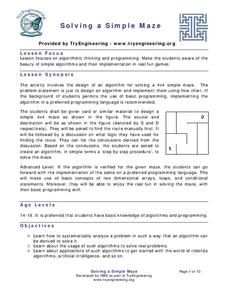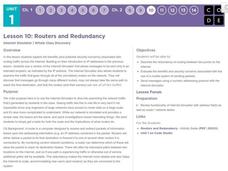Teach Engineering
Automatic Floor Cleaner Computer Program Challenge
Have your class use the engineering design process to program a vacuum robot. Using computer engineering concepts, teams program an automatic floor cleaner to traverse designated patterns.
TryEngineering
Program Your Own Game
Young computer scientists get to see what it's like to be a software engineer as they use free online software to design a computer game. They play and evaluate games groups created to round out the activity.
Code.org
The Need for Programming Languages
LEGO see if you can recreate my design. Individuals build an arrangement from LEGO blocks and write directions for someone else to follow in order to recreate the arrangement. Pairs then swap directions and try to...
Curated OER
Linear Programming
In this algebra worksheet, students calculate the maximum and minimum of a shaded region. They identify the boundaries and their vertices's. There are 2 problems.
TryEngineering
Solving a Simple Maze
Solve a maze ... from a robot's point of view. In the lesson plan, your scholars build a small, simple maze from cardboard and then find a route from the start point to the finish point. They write an algorithmic process that a robot...
Concord Consortium
Vending Machine
Let the resource quench your thirst for knowledge, like a vending machine that dispenses drinks. Future computer scientists develop an algorithm to identify the fewest number of coins that a vending machine could use in creating change....
TryEngineering
Solving Problems with Decision Trees
Combat crime with computers. The instructional activity teaches young computer scientists about decision trees and how to use them. They consider telecommunications subscriptions and how decision trees can help detect fraud.
Teach Engineering
Storing Android Accelerometer Data: App Design
There's an app for that! Pupils learn to build an app that will store data on an Android. The instructional activity introduces class members to the tiny database, TinyDB, for Android devices. A video tutorial provides an...
TryEngineering
Arduino Blink Challenge
Who knew turning a light on and off could be so complicated? In the instructional activity, pupils use Arduino boards to learn about computer codes and programs. They program an Arduino to make a light turn on and off at certain time...
Curated OER
Breaking English News: Children Into Computers Younger Than Ever
For this ESL/ELL reading and listening comprehension worksheet, learners read or listen to an article entitled, "Children Into Computers Younger Than Ever." They complete discussion activities, and matching, true or false, fill in the...
Drexel University
Learning Roomba Module 4: Sensors and Actuators
Introduce your classes to sensors and actuators in robots — specifically to the Roomba. Pupils develop programs that make Roomba utilize its different sensors.
TryEngineering
Computing in the Cloud
What and where is "the cloud"? The instructional activity teaches scholars about the history of cloud computing and about its current uses. It also teaches how to install a multiple guest OS in a host OS and how to use cloud computing...
Code.org
Routers and Redundancy
How are messages to the right recipient? Introduce the concept of routing Internet traffic by drawing a comparison to sending a letter. Groups use the Internet Simulator program to send messages to others using the same router...
National Security Agency
Classifying Triangles
Building on young mathematicians' prior knowledge of three-sided shapes, this lesson series explores the defining characteristics of different types of triangles. Starting with a shared reading of the children's book The Greedy...
PLS 3rd Learning
eHealth Insurance
Comparison shop for health insurance? Yep. Young adults compare and contrast several health insurance plans to determine which would provide the most coverage at the best price. They discuss and work through deductibles, premiums, and...
TryEngineering
Give Binary a Try!
Digital, analog, and now binary clocks? The lesson teaches individuals how to interpret binary code. They use an online software program to read binary clocks.
Code.org
Functions and Top-Down Design
Let me break it down for you! Introduce your class to a way of breaking up a complicated task into its component pieces. Individuals draw a complex figure using JavaScript and then break it down to help determine the...
Curated OER
Computer Security Day
In this computer security day instructional activity, students match phrases, fill in the blanks, choose the correct words, unscramble words and sentences, write discussion questions and conduct a survey.
Curated OER
Air Force Trains Warriors to Defend Cyberspace from Terror
Students explore the use of computers in the military. In this lesson, students read an article on plans the Air Force is making to increase their use of computers to fight terrorism, then participate in a discussion on the...
Code.org
The Need for Algorithms
Pairs work through two scenarios that require them to generate an algorithm. The first activity requires pairs to define a common language to use; the second comes with the language. The pairs then must determine how to code the...
Teach Engineering
Android App Development
Building an accelerometer app for your Android device. Groups develop an app that uses the accelerometer on an Android device. The purpose of the activity is to reinforce the programming design. The post activity assessment challenges...
EngageNY
Logarithms—How Many Digits Do You Need?
Forget your ID number? Your pupils learn to use logarithms to determine the number of digits or characters necessary to create individual ID numbers for all members of a group.
TryEngineering
Circuits and Boolean Expressions
Teach basic logic using Boolean operators. Young computer scientists learn about the operators NOT, AND, and OR, and how they can be expressed using Boolean notation, logic gates, or truth tables. Along the way, they learn about half...
Curated OER
Breaking News English: New Computer Art Mirrors Viewer's Mood
In this English worksheet, students read "New Computer Art Mirrors Viewer's Mood," and then respond to 47 fill in the blank, 7 short answer, 20 matching, and 8 true or false questions about the selection.























